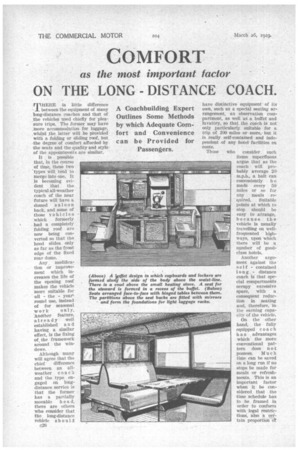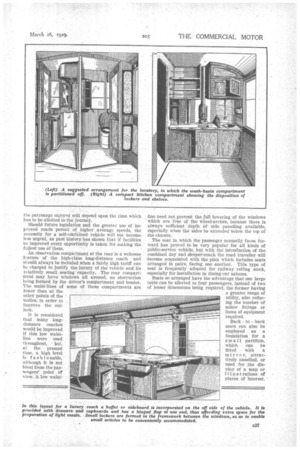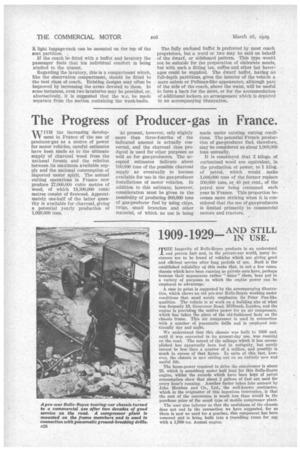COMFORT
Page 56

Page 57

Page 58

If you've noticed an error in this article please click here to report it so we can fix it.
as the most important factor
ON THE LONG DISTANCE COACH.
THERE is little difference between the equipment of many long-distance coaches and that of • the vehicles -used chiefly for pleasure trips. The former may have
more aceonntaxiation for luggage,
, whilst the latter. will be provided with a folding or sliding roof, but -the degree of comfort afforded by the seats and the .quality and style
of the appointments are similar.
It is possible that, in the course of time, these two types will tend to merge into one. It is becoming evident that the typical all-weather coach of the near future will have a domed `saloon back, and some of those vehicles which formerly had a completely folding roof are now being converted so that the hood slides only as far as the front edge of the fixed rear dome.
Any modification or improvement which increases the life of the opening roof makes the vehicle more suitable for all the yearround use, instead of for seasonal work only. 'Another feature, already well established a n d having a similar effect, is the fixing of the framework around the windows.
Although many will agree that the chief • difference between an allweather c o a cii and the type engaged on longdistance service is that the former has a partially movable head, there are others Who consider that the long-distance vehicle should
c26 have distinctive equipment of its own, such as a special seating ar-.
rangement, an observation compartment, as well as a buffet and :lavatory, so that the coach is not
only particularly, suitable for a trip of 100 miles or more,but it
is really self-contained and independent of any hotel facilities en route.
Those who consider such items superfluous argue that as the coach • will probably average 20 m.p.h., a halt can conveniently b c made every 50 miles or so for any meals re quired. Suitable points at which to stop should be easy to arrange, because the vehicle is usually travelling on well frequented highways, upon which there will be a number of goodclass hotels.
Another argument against the self contained long distance coach Is that spe cial compartments occupy excessive space, with a consequent reduc tion in seating and, therefore, in the earning capa city of the vehicle. On the other hand, the fully equipped c on c h has ad vantages which the more conventional pat tern does not possess. M uc h time can be saved on a long run if no stops be made for meals or refresh ments. This is an important factor when it be con sidered that the time schedule has to be framed in order to conform with legal restric
tions, also ceiL tain proportion dr
the patronage enjoyed will depend upon the time which has to be allotted to the journey.
Should future legislation and the greater use of improved roads permit of higher average speeds, the necessity for a self-contained vehicle will not become less urgent, as past history has shown that if facilities be improved every opportunity is taken for making the fullest use of them.
An observation compartment at the rear is a welcome feature of the high-class long-distance coach and should always be included when a fairly high tariff can be charged to justify the luxury of the vehicle and its relatively small seating capacity. The rear compartment may have• windows all around, no obstruction being formed by the driver's compartment and bonnet. The waist-lines of some of these compartments are lower than at the other points of the bodies, in order to improve the outlook.
Jt is considered that many longdistance coaches would be improved if this low waistline were used throughout, lout, at the present time, a , high level is fashionable, although it is not Ideal from the passengers point of view. A low waist line need not prevent the full lowering of the windows which are free of the wheel-arches, because there is always sufficient depth of side panelling available, especially when the sides be extended below the top of the chassis.
The seat in which the passenger normally faces forward has , proved to be very popular for all kinds of public-service vehicle, but with the introduction of the combined day and sleeper-coach the road traveller will ,become acquainted with the plan which includes seats arranged in pairs, facing one another. This type of seat is frequently adopted for railway rolling stock, especially for installation in dining-car saloons.
Seats so arranged have the advantage that one large table can be allotted to four passengers, instead of two of lesser dimensions being required, the former having a greater range of utility, also reducing the number of minor fittings or Items of equipment required.
Back to back seats can also be employed as a foundation for a small partition, which can be fitted with a mirro r, attractively panelled, or used for the display of a map or illustrations of places of interest. light luggage-rack can be mounted on the top of the seat partition. .
If the coach be fitted with a buffet and lavatory the passenger feels that his individual comfort is being studied to the utmost.
Regarding the lavatory, this is a compartment which, like the observation compartment, should be fitted to the best class of coach. Existing designs may often be improved by increasing the areas devoted to them. In some instances, even two lavatories may be provided, or, alternatively, it is suggested that the w.e. be made separate from the section containing the wash-basin. The fully enclosed buffet Is preferred by most coach Proprietors, but a word or two may be said on behalf of the dwarf, or sideboard pattern. This type would not be suitable for the preparation of elaborate meals, but with such a fitting tea, coffee and other hot beverages could be supplied. The dwarf buffet, having no full-depth partitions, gives the interior of the vehicle a more saloon or Pullman-like appearance, although parr of the side of the coach, above the waist, will be useful to form a back for the stove, or for the accommodation of additional lockers, an arrangement which is depicted in an accompanying illustration.




























































































































